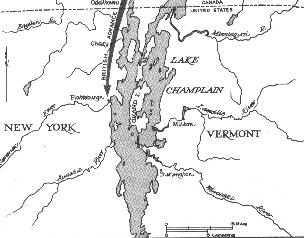


Captain George Downie, the new British naval commander faced the difficult task of getting his new ship ready for service in a few days. Sir George Prevost had sent letters to Downie urging him to attack the American fleet even as the carpenters were still busy completing work on the British frigate. Prevost led the largest British army across the border during the entire war, the British troops brushed American Militia units aside with ease. On the 6th , Prevost halted on the north side of the Saranac River across from Plattsburgh. On the other side, about 3,000 U.S. troops worked hard to strengthen the fortifications while the militiamen of New York and Vermont flocked in and skirmished with the British along the river. Nearby in Plattsburgh Bay, Captain Thomas Macdonough's squadron of four ships and ten gunboats lay at anchor. Prevost decided to wait for Captain Downie to arrive with his fleet so that the army and the navy could attack at the same time. Everyday more and more letters came urging Downie to hurry his ships down to Plattsburgh. Captain Downie did not dare attack without his new frigate, he was still making up crews for his vessels as late as September 9th, and the frigate was not completely finished when it sailed with the sqaudron before dawn on the 11th.
The British and American fleets began battling between 8 a..m. and 9 a.m. Only minutes later, Captain Downie was killed but a fierce fight continued for two hours. Then the British who had suffered great losses struck the ships colours and surrendered. The British officers proceeded to the Saratoga to surrender their swords. As they step aboard the American ship, Captain Macdonough meets them, and bows. Holding their caps in their left hands and their swords by the blades, the British officers advance, bowing, and present their weapons to the American commander. Macdonough bows once more. "Gentlemen, return your swords into your scabbards and wear them," he says "You are worthy of them."
Prevost did not launch his assault on the American land defences when the naval battle began. He ordered Major General Frederick P. Robinson to start the attack at 10 a.m. An hour or so later, most of the troops had crossed the Saranac River and were forming up to charge the American positions. Robinson and his troops, veterans of battles against tough French soldiers, regarded the American positions as an easy target. Their self confidence was never put to the test however, because Prevost halted the land attack as soon as Downie's fleet surrendered. He ordered the troops to destroy their extra supplies and retreat. The army arrived back in Canada virtually unharmed.
The entire Plattsburgh campaign had failed, achieving nothing except the destruction of the British naval force on Lake Champlain. Many British officers felt Prevost had brought disgrace on the army. They had complained about his leadership before the ill-fated invasion, and now their criticisms increased. They maintained that their troops could have easily have captured Plattsburgh even without Downie's fleet. The army would have had to withdraw, but it could have done so after a victory instead of appearing to flee from a defeat.